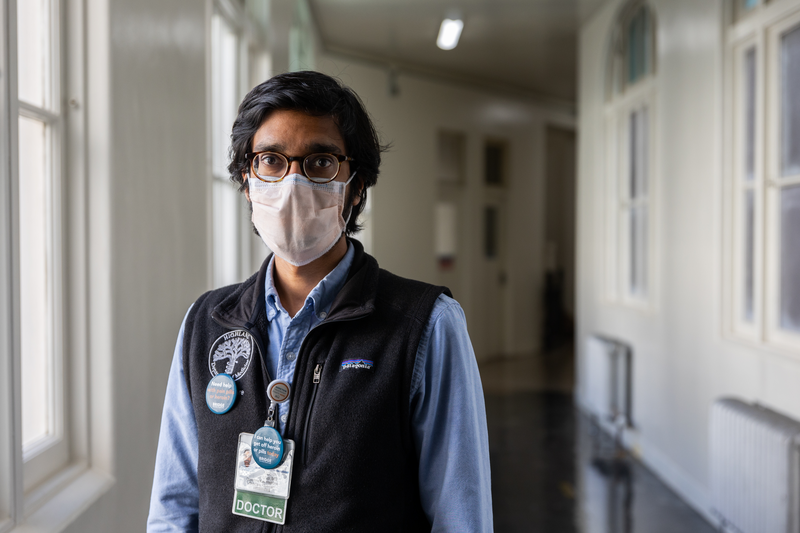Originally published on The Oaklandside.
By
Health experts and social workers say meth use and harms associated with it are rising fast and treatment options are limited.
In an older wing of Oakland’s historic Wilma Chan Highland Hospital Campus, a patient waits on an examination table. He is there to receive a monthly dose of Sublocade, the brand name for the injectable form of buprenorphine, a medicine that helps people suffering from opioid addiction curb cravings and avoid withdrawal symptoms while trying to get clean.
He twitches only slightly when Dr. Monish Ullal, a physician at the Alameda Health System’s innovative Bridge Clinic for substance use disorder, inserts the needle into his abdomen. He prefers to come to the clinic on Wednesdays, when Ullal is on the floor, because of his gentle touch.
“It really helps with the cravings,” says the patient, who has been clean for 10 months. “Except for some,” he clarifies. “Except for meth.”
Methamphetamine, a highly addictive stimulant drug, is on the rise in Oakland. In both its quantity on the streets and the number of people who die from using it, meth comes second only to opioids (including fentanyl and heroin) in Alameda County. But unlike fentanyl and other opioids, which have buprenorphine as a medicated treatment option, there isn’t yet a drug on the market that can treat patients’ meth addictions.
Over the past five years, meth has become more available, potent, and cheap than ever before. As a result, the number of people who use meth has soared, making the drug a serious public health problem.
Dr. Erik Anderson, an emergency medicine physician at Oakland’s Highland Hospital, described fentanyl and meth as by far the most harmful illicit drugs impacting Oakland today. Originally from the Midwest, Anderson specializes in addiction medicine. He said there is an unmet need for substance use disorder treatment across the country.
During his years at Highland, Anderson has seen meth become more prevalent and dangerous in ways that mirror the trajectory of the opioid crisis.
“People have been using meth for a while, including in the East Bay, but it has become even more common,” he said, painting a picture of how Oakland’s drug scene has changed over time. “It’s not an opioid, but it has seen increasing mortality, hospital visits, and emergency department visits associated with its use.”
Because of the drug’s low cost and stimulating effects, meth usage is especially prevalent in Oakland’s unhoused population. Charles Hawthorne, who has worked in harm reduction for seven years as an educator and program manager, runs training sessions for addiction professionals that emphasize how substances, including meth, have utility for the people that use them.
“Meth helps people stay awake, navigate pain, have less feelings of hunger, and stay safe on the streets,” said Hawthorne, who works as an equity and harm reduction project manager at CA Bridge, a state-wide addiction treatment and hospital training program based in Oakland that grew out of the work done at Highland. For people experiencing homelessness, the stimulating effects of meth can help them survive the challenging realities of living unhoused. “If you’re a person who is living on the streets, every time you fall asleep, you risk being robbed, assaulted, or killed,” said Hawthorne.
But today’s meth is more dangerous than it was a decade ago. Across the state, the supply is laced with fentanyl, causing deadly overdoses. Even unadulterated meth is more potent than ever and can cause behavioral health issues or psychosis at an astonishing rate.
Despite this reality, the meth crisis is being given far less attention in the media than the harms caused by fentanyl. And experts say that the public health system is in many ways playing catchup to the problem. The Alameda County Public Health Department has made strides in its initiatives to reduce the harm caused by opioids, but its website is virtually devoid of materials on meth. A basic search for “methamphetamine” yields a single article about a fentanyl overdose from January 2020. But the department does acknowledge there’s an increase in meth’s prevalence in the county in recent years.
“Currently a significant percentage of individuals who meet criteria for methamphetamine-use disorder experience methamphetamine-associated psychosis, anxiety and mood disorders,” said Neetu Balram, a spokesperson for the public health department. “[M]ethamphetamine use and psychiatric symptoms precipitated by methamphetamine use are major drivers of psychiatric emergency services and psychiatric hospitalizations in Alameda County.”
The medical professionals and addiction experts we spoke with are in universal agreement: meth is a growing issue in Oakland. They say that its rise is one piece in a larger puzzle of socio-economic and health crises facing the community.
“One thing that we hear all the time in California and nationally is ‘we don’t have an opioid problem, we have a methamphetamine problem.’ This is a constant conversation,” said Sarah Windels, a founding member of CA Bridge.
“It’s just wildly common,” said Anderson of meth’s wide reach in Alameda County.
To better understand the growing meth crisis in Oakland and Alameda County, The Oaklandside spent time talking with public health experts, social workers, and law enforcement officials who treat addiction, assist communities disproportionately harmed by the influx of dangerous drugs, and gather data on the scale of the problem.
Read the full article on The Oaklandside, here.


